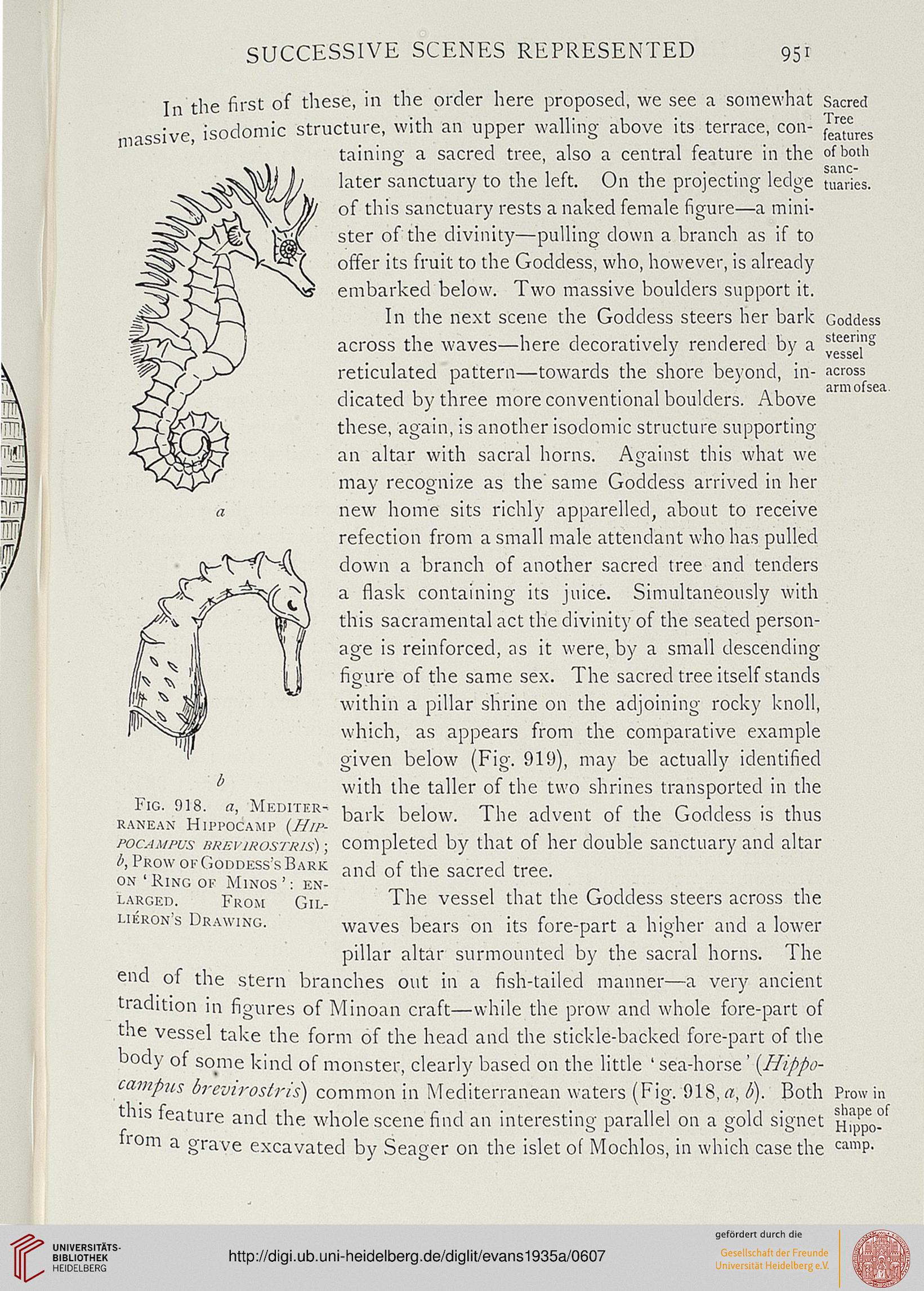SUCCESSIVE SCENES REPRESENTED
95i
massive,
sanc-
aries.
Goddess
steering
vessel
across
armofsea.
In the first of these, in the order here proposed, we see a somewhat Sacred
isodomic structure, with an upper walling above its terrace, con- futures
taining a sacred tree, also a central feature in the of both
later sanctuary to the left. On the projecting ledge tttar
of this sanctuary rests a naked female figure—a mini-
ster of the divinity—pulling clown a branch as if to
offer its fruit to the Goddess, who, however, is already
embarked below. Two massive boulders support it.
In the next scene the Goddess steers her bark
across the waves—here decoratively rendered by a
reticulated pattern—towards the shore beyond, in-
dicated by three more conventional boulders. Above
these, again, is another isodomic structure supporting
an altar with sacral horns. Against this what we
may recognize as the same Goddess arrived in her
new home sits richly apparelled, about to receive
refection from a small male attendant who has pulled
down a branch of another sacred tree and tenders
a flask containing its juice. Simultaneously with
this sacramental act the divinity of the seated person-
age is reinforced, as it were, by a small descending
figure of the same sex. The sacred tree itself stands
within a pillar shrine on the adjoining rocky knoll,
which, as appears from the comparative example
given below (Fig. 919), may be actually identified
with the taller of the two shrines transported in the
bark below. The advent of the Goddess is thus
completed by that of her double sanctuary and altar
and of the sacred tree.
The vessel that the Goddess steers across the
waves bears on its fore-part a higher and a lower
pillar altar surmounted by the sacral horns. The
end of the stern branches out in a fish-tailed manner—a very ancient
tradition in figures of Minoan craft—while the prow and whole fore-part of
the vessel take the form of the head and the stickle-backed fore-part of the
body of some kind of monster, clearly based on the little ' sea-horse' {Hippo-
campus brevirostris) common in Mediterranean waters (Fig. 918, a, 6). Both Prow in
this feature and the whole scene find an interesting parallel on a gold signet Hippo?
from a grave excavated by Seager on the islet of Mochlos, in which case the camP-
Fig. S18. a, Mediter-
ranean Hippocamp (Hip-
pocampus BKEVIROSTRIS) ;
b, Prow of Goddess's Bark
on ' Ring op Minos ': en-
larged. From Gil-
lieron's Drawing.
95i
massive,
sanc-
aries.
Goddess
steering
vessel
across
armofsea.
In the first of these, in the order here proposed, we see a somewhat Sacred
isodomic structure, with an upper walling above its terrace, con- futures
taining a sacred tree, also a central feature in the of both
later sanctuary to the left. On the projecting ledge tttar
of this sanctuary rests a naked female figure—a mini-
ster of the divinity—pulling clown a branch as if to
offer its fruit to the Goddess, who, however, is already
embarked below. Two massive boulders support it.
In the next scene the Goddess steers her bark
across the waves—here decoratively rendered by a
reticulated pattern—towards the shore beyond, in-
dicated by three more conventional boulders. Above
these, again, is another isodomic structure supporting
an altar with sacral horns. Against this what we
may recognize as the same Goddess arrived in her
new home sits richly apparelled, about to receive
refection from a small male attendant who has pulled
down a branch of another sacred tree and tenders
a flask containing its juice. Simultaneously with
this sacramental act the divinity of the seated person-
age is reinforced, as it were, by a small descending
figure of the same sex. The sacred tree itself stands
within a pillar shrine on the adjoining rocky knoll,
which, as appears from the comparative example
given below (Fig. 919), may be actually identified
with the taller of the two shrines transported in the
bark below. The advent of the Goddess is thus
completed by that of her double sanctuary and altar
and of the sacred tree.
The vessel that the Goddess steers across the
waves bears on its fore-part a higher and a lower
pillar altar surmounted by the sacral horns. The
end of the stern branches out in a fish-tailed manner—a very ancient
tradition in figures of Minoan craft—while the prow and whole fore-part of
the vessel take the form of the head and the stickle-backed fore-part of the
body of some kind of monster, clearly based on the little ' sea-horse' {Hippo-
campus brevirostris) common in Mediterranean waters (Fig. 918, a, 6). Both Prow in
this feature and the whole scene find an interesting parallel on a gold signet Hippo?
from a grave excavated by Seager on the islet of Mochlos, in which case the camP-
Fig. S18. a, Mediter-
ranean Hippocamp (Hip-
pocampus BKEVIROSTRIS) ;
b, Prow of Goddess's Bark
on ' Ring op Minos ': en-
larged. From Gil-
lieron's Drawing.





